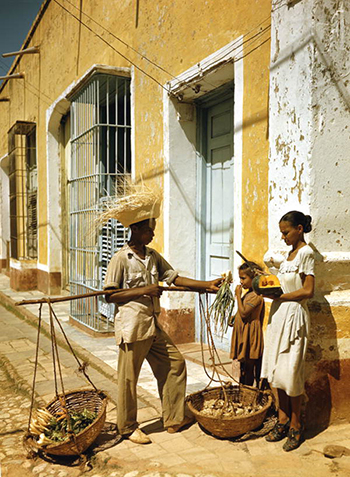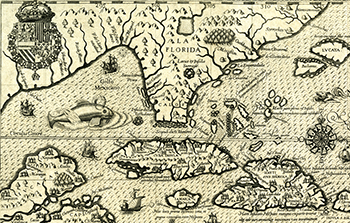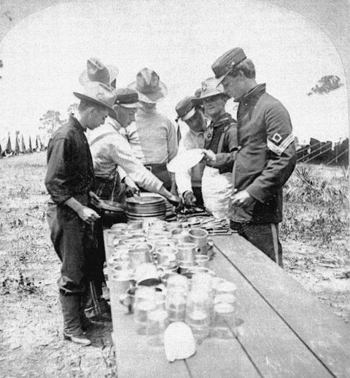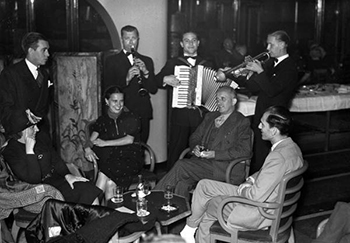The Cuban Experience in Florida: Revolution and Exodus
Photos and History
Cuba, Florida's Neighbor
Any tourist who’s been to Key West knows that Florida is only 90 miles from the island of Cuba. Since the Cuban Revolution of 1959, this distance has seemed far greater. Few tourists snapping photos at the Southernmost Point know how close the two nations once were. For many Americans and Cubans alike, Cuba before the revolution seemed like an extension of the United States.
Street vendor holding out onions to a woman holding tropical fruit in Cuba (between 1940 and 1959)
Image number: JJS0971
Florida photographer Joseph Janney Steinmetz traveled to Cuba before the Revolution.
Steinmetz was a world-renowned commercial photographer whose images appeared in such publications as The Saturday Evening Post, Life, Look, and Time. His work has been referred to as "an American social history," which documented diverse scenes of American life, from affluent northeasterners to middle-class Floridians.
The history of the lands now known as Florida and Cuba were intertwined long before the Revolution of 1959 resulted in an exodus of refugees to the United States. Thousands of years before the arrival of Europeans and Africans, Native peoples traveled from the mainland to the islands and vice versa in dugout canoes. These indigenous peoples, known as the Calusa, Tequesta, Taíno, Arawak and Carib, established well-worn trade routes by the time Europeans and Africans arrived in 1492.
Europeans and Africans Arrive
The first Spanish explorers to reach what is now Florida sailed from Puerto Rico in April 1513. Subsequent voyages led by Pánfilo de Narváez and Hernando de Soto arrived in Florida from Cuba in the 1520s and 1530s. Spanish conquistadors repeatedly tried to pacify Florida before establishing the outpost of St. Augustine in 1565. From the founding of the oldest permanent European settlement in North America to the end of the first Spanish period in 1763, Cuba depended on Florida for everything from corn and beef to deerskins and seafood.
Map of the Caribbean including Florida and Cuba (1591)
Image number: RC03327
Cattle and Cigars
Commerce between Cuba and Florida thrived in the 19th and 20th centuries, until ending abruptly in October 1960 with a trade embargo enforced by the United States government. Florida supplied beef to Cuba from Punta Rassa, south of today’s Fort Myers, throughout the 19th century. The Cuban cigar industry relocated to Florida during Cuba’s political crises of the 1870s, 1880s and 1890s. Key West and Ybor City teemed with Cuban immigrants, Cuban-owned businesses, and revolutionary sentiment. Revolutionary leaders such as Jose Martí traveled to Florida during Cuba’s War for Independence and found ample support for the struggle against Spain.
Close-up of cigar worker (192-)
Image number: HR024
Cuba Libre—The Struggle for Independence
The struggle for Cuban independence, culminating in what is known as the Spanish -American War, began a process whereby the United States exerted significant influence over Cuban affairs. Following the defeat of Spain in 1898, American companies invested heavily in Cuban industry, particularly sugar cane. American investors financed the modernization of Cuba’s infrastructure and brought baseball to the island, but also heightened existing racial tensions. Foreign investors refused to hire persons of color for anything but menial positions in the American-owned sugar factories. Segregationist hiring practices fueled anger towards the Americans, especially among Afro-Cubans and the lower classes.
Company D Florida volunteers at dinner: Tampa, Florida (1898)
Image Number: PR10231
Middle and upper class Cubans generally benefited from close ties to the Americans. Wealthy Cubans traveled to Florida, just as well-off Americans vacationed in Cuba. Havana mirrored Miami’s Art-Deco architecture, and both became cosmopolitan cities. However, below the gleaming surface of Havana’s nightlife festered a world of gambling, liquor trafficking and prostitution. For many Cubans, especially those who later joined the revolutionary movement, these problems exposed the failures of political and economic independence. They blamed politicians for catering to the United States at the expense of Cuban sovereignty. Popular discontent also stemmed from ineffective political leaders. A reform movement in the early 1930s led to the creation of a constitution that granted greater freedoms to the Cuban people. Most aspects of the constitution never went to effect, however, and the Cuban people suffered under a succession of dictatorships.
Guests and musicians traveling between Miami, Florida and Havana, Cuba (1948)
Image number: JJS1496
Florida photographer Joseph Janney Steinmetz took this photograph of guests and musicians aboard the S.S. Florida of P. & O. Line traveling between Miami and Havana.
The Revolution
The revolution changed Cuba forever. Discontent developed many years before Fidel Castro and the 26th of July Movement seized control in early 1959. The Cuban Revolution immediately curtailed American influence on the island. The revolutionary government seized American-owned property in October 1960. The United States responded with an embargo, which remains in effect to the present day.

 Listen: The Assorted Selections Program
Listen: The Assorted Selections Program




